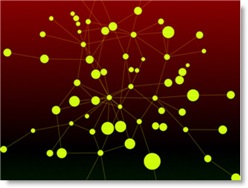Several days ago, I had an exchange over email about how to pitch Lotus Connections to a customer in the Energy Industry. This is a summary of the ideas that Ted Stanton, Laurisa Rodriguez, and myself came up with.
What seems to be a common thread in the Energy Industry is that it's facing an Aging Workforce. This is something that I first ran into when I met a customer in this same industry in Rio de Janeiro a couple of months ago. In this case, the pain points for customers are that they fear they will be affected by brain drain. How do you capture this knowledge before it's gone? Well, with social software, of course!
I consider myself a seeker and a contributor. I am always looking for an expert on something and I like to share my content. Before I adopted social software, however, I found myself turned off by the Knowledge Management (KM) solutions that existed within my enterprise. We had way too many databases. I kept asking myself: "Where should I post my content?" "Where are users searching for content?" "Why don't I have access to some databases?" "Why doesn't any of the existing databases have keywords/categories appropriate for my content?", etc. I'm sure these frustrations are shared by others as well.
How does social software, in particular, Lotus Connections help? Let's look at its capabilities:
- Profiles - Can be extremely valuable even if users don't manually populate information as much of the data can be pulled from existing enterprise data sources. The ability to integrate profile searches from email clients is something any age group likes.

- Communities - Owners of Communities can invite and recommend communities to other employees. Forums are extremely powerful and communities can become the place where people ask questions to a larger audience. Everyday people ask me questions, I advise them to check the forum and if you don't get what you need, create a post.
- Blogs - It only takes 1 person on a team to share information. If you have a 10 person team and 9 of them don't blog (over 50 crowd), that's OK. It only takes 1 person to take the best practices and lessened learned from the team and share them across the enterprise. This is kind of informal mentoring.
- Dogear - No brainier. Everyone has bookmarks. There is relatively no difference between bookmarking locally in a browser or through Dogear. Need to show users how easy it is to get started. Adding a "Dogear This" button to all internal web pages and integrating Dogear search results with the existing enterprise search engine starts viral adoption. When people ask me for links, I tell them to go search Dogear first.
- Activities - While this may be tough for baby boomers to adopt, the key is to find advocates of all ages. Once these advocates understand the technology and how to collaborate effectively with it, inevitably others will follow as they get added to subsequent activities.
Finally, any social software solution that follows the 10 principles of social software architecture must be easy to use. This simplicity reduces the time that it takes to learn how to use social software, it gets users on board more rapidly, and increases adoption. Lotus Connections, for example, was designed with usability in mind. It's really easy to use!